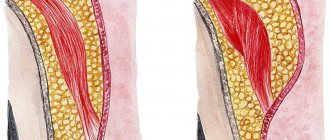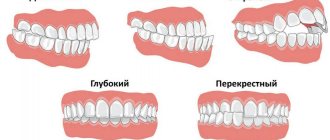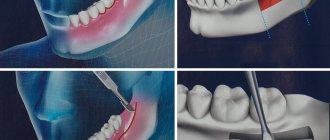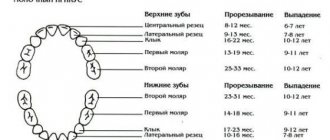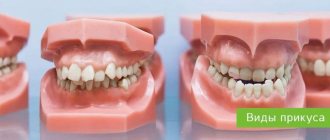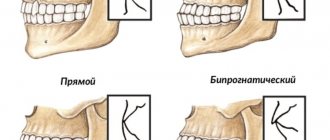- Surgical department
Surgical department » - Maxillofacial Surgery
Maxillofacial Surgery "
- Jaw osteotomy
Malocclusion is a violation of the process of chewing food and swallowing it, a negative effect on the speech apparatus, as well as an aesthetic defect. With malocclusions, the upper and lower jaws can be enlarged or reduced in size, pushed forward or positioned posterior to the normal position, shifted to the side or tilted, turning clockwise or counterclockwise. In this case, the closure of the teeth is disrupted to one degree or another, they change the angle of inclination, turn around, run into each other (crowding) or diverge with the formation of cracks (treme).
What are the dangers of malocclusion?
- Violation of dental contacts makes it difficult to chew food and provokes the development of diseases of the gastrointestinal tract.
- Severe malocclusions so limit the possibilities of normal nutrition that they are a reason for deferment from the army.
- Changing the angles of inclination of the teeth affects the distribution of the load during chewing, leads to overload of the periodontium, the development of gum inflammation and, ultimately, earlier tooth loss.
- Teeth crowding, combined with misalignment, affects the natural cleaning of teeth, further leading to the development of gum disease and an increased likelihood of tooth enamel destruction. If tooth loss has already occurred, then violations of the jaw relationships can create difficulties in prosthetics.
- Malocclusion leads to a change in the trajectory of jaw movement during chewing: the temporomandibular joints are overloaded, and dysfunction of the temporomandibular joints develops.
- Some types of malocclusion are anatomical prerequisites for narrowing the airways, for the appearance of snoring and such a serious condition as sleep apnea.
Results of orthognathic surgery
Orthognathic surgery transforms a person, giving him the opportunity to look more beautiful, younger, and do what he loves without being embarrassed by his own appearance. A symmetrical face shape is not only beautiful: maxillofacial anomalies are accompanied by disruption of many body systems, leading to deterioration in breathing, chewing food and diseases of the gastrointestinal tract.
With the help of surgical treatment, it is possible to change the length of the jaw, its position and shape, and improve the condition of the chin. As a result of timely correction, the appearance is transformed, facial features become symmetrical and the overall health of a person improves.
Due to the fact that the surgeon makes all the incisions from the inside, the integrity of the external tissues and the beauty of the facial skin are preserved. Surgical treatment is not accompanied by the appearance of scars and other residual effects. The patient receives maximum aesthetic results and gets rid of malocclusions, which often lead to speech and chewing disorders.
If you suffer from severe malocclusions that cannot be completely corrected with braces or other orthodontic options, you can schedule a consultation with our Clinic's oral and maxillofacial surgeon online or via Skype.
The specialists of the CONSTANTA Clinic in Yaroslavl have many years of experience in the field of plastic and aesthetic surgery. They have at their disposal modern methods of bite correction and safe methods of surgical intervention. Surgeons are focused on the interests of patients and the safest and most effective elimination of anomalies and defects in the structure of the dental system.
Preparing for surgery
Consultation with a plastic surgeon
Before the start of the preparatory period and a comprehensive examination, the doctor must conduct a conversation with the patient in order to warn him about possible risks and contraindications, develop an individual occlusion correction scheme and a surgical intervention plan. The specialist must exclude the presence of diseases that can cause complications both during the operation and in the postoperative period.
Laboratory tests and choice of anesthesia
Before the operation, the patient undergoes a comprehensive examination, which includes laboratory tests. Diagnostic data is carefully studied by the operating surgeon and anesthesiologist, who plan consultations and choose the optimal type of surgery and anesthesia option.
Comfortable postoperative period
From the first minute you contact our specialists, qualified employees who are interested in the successful outcome of the operation will work with you. The rooms are equipped with functional beds and have everything necessary for a comfortable stay. At any time you can call the Clinic’s specialists, get answers to your questions or receive qualified medical assistance.
Personal manager for operation planning
Each patient can use the free Personal Manager service. To do this, you need to call the phone number (4852) 37-00-85 or inform us of your desire to use the service by writing to For out-of-town patients, we offer correspondence consultation via Skype or e-mail.
Jaw osteotomy surgery
Historically, the first operations were performed on the lower jaw. And the surgeon’s task was precisely to restore normal jaw relationships. But today operations on the lower jaw alone account for no more than 10% of operations performed. Because the surgeon’s tasks have changed: now it is not only the correction of the bite, but also the improvement of facial aesthetics.
Double-jaw osteotomy is an operation on the lower and upper jaw simultaneously, which allows you to achieve aesthetically favorable proportions of the face both in front and in profile, eliminate asymmetry, and make the smile brighter by eliminating dark corridors - shading of the lateral teeth of the upper jaw. We can say that surgery on one jaw is only a correction of functionality, on two – functionality and aesthetics.
Indications for the operation:
- violation of the closure of the dentition, which cannot be corrected orthodontically;
- pronounced facial disproportions that have aesthetic significance.
Contraindications:
- unpreparedness of the dentition for surgery (insufficient orthopedic or orthodontic preparation);
- diseases of internal organs that prevent surgery or anesthesia.
How much does it cost to correct an overbite surgically?
The full cost of maxillofacial surgery is indicated at the bottom of the page. It includes:
- consultation with an anesthesiologist;
- orthognathic surgery;
- anesthesia in the operating room;
- stay in the Clinic ward with meals;
- full post-operative observation and care.
You can pay for the transaction in cash, by credit card or by bank transfer.
A patient of our Clinic can receive a tax deduction from the cost of correcting a bite using orthognathic surgery.
Stages of treatment
Today, the method of combined treatment of malocclusions, when the orthodontist begins work first, is considered generally accepted in the world.
1) Orthodontic stage
The orthodontist places braces on both jaws and begins to move the teeth so that they take the correct position in relation to the jaws. In this case, a temporary deterioration in the closure of teeth occurs. It takes about nine months to prepare. After this, the surgical stage is performed.
2) Surgical stage
The operation is performed under general anesthesia. The intervention is performed via intraoral access, which allows it to avoid leaving scars. In accordance with the treatment plan, cuts are made on the upper and lower jaws, the fragments are mobilized and installed in the most functionally and aesthetically advantageous position. Next, the jaws are fixed with titanium miniplates, which are invisible to the body, do not ring at the airport and do not interfere with MRI. They usually remain in the body for life without causing any consequences. In rare cases, surgery may be performed before orthodontic treatment begins.
Rehabilitation after osteotomy
Let's consider the recovery period after surgery using the example of corrective osteotomy.
The patient is in the hospital under the supervision of doctors for 3 to 7 days. At this time, regular treatment of the surgical wound is carried out, painkillers, antibiotics and anti-thromboembolism drugs are given. It is important to start getting up as early as possible and not to lie around.
After discharge, the patient must continue taking the prescribed medications at home. On the 10-14th day, the sutures are removed. Next, rehabilitation is indicated - the use of crutches for up to 6-12 weeks, regular visits to the doctor for examinations. Heavy physical activity will be allowed only 6-8 months after the operation. Sometimes installed metal structures are removed after 1-2 years.
Orthodontic preparation for surgery and its detailed planning
Orthognathic surgery is designed to achieve a radical effect in harmonizing facial features and giving the smile an aesthetic appearance, so preparation for it is carried out in the most careful manner.
The most important stage of preliminary treatment is wearing orthodontic structures. However, in this case, specially selected braces and arches do not correct the bite, but prepare the dentition in such a way that during the operation, after moving the jaw bones, they form optimally.
Orthodontic preparation usually takes from 3 to 18 months. The duration depends on the severity of the skeletal deformity and the individual response of each patient to therapy.
All orthodontic manipulations are pre-modeled using interactive three-dimensional computer planning programs Nemotec and Dolphin 3D. The programs allow you to visually trace each stage of tooth movement and predict the final result. Computer simulation helps not only to optimize the interaction between the orthodontist and the surgeon, but to demonstrate to the patient extremely inspiring treatment prospects.
3D planning – full diagnostics as a guarantee of results
To plan how the proportions of the face will change after orthodontic treatment and surgery itself, photography, computed tomography, and the creation of plaster and STL models are carried out. Based on computer processing of diagnostic data, specialists determine the maxillofacial parameters required for the correct functioning of the temporomandibular joint, correct contact between teeth and harmonization of facial features, select the optimal management tactics, manufacture orthodontic structures and plan the course of the operation.
Plates for jaw fracture
The use of plates after a jaw fracture is justified when a conservative treatment method either does not give the desired result (correct reposition and high-quality fusion of bone parts) or cannot be used initially (complex injury). The decision to perform an operation is made by the doctor after examining the patient (examination if treatment methods other than surgery have already been used).
The advantage of bone osteosynthesis is that when plates are installed to connect fragments, the lesion site is well supplied with blood. This ensures fairly rapid fusion - in just a few weeks - while restoring the bone itself (integrity) and its anatomically correct structure.
3D planning of orthognathic surgery
Before
Photo of a face
Photo of a face
Performing an optical scan of the dentition. Optical model of dentition
Performing an optical scan of the dentition. Optical model of dentition
Orientation of the head in space according to the skin
Combining jaw scans with computed tomography
Orientation of the skull in space
3D cephalometric analysis
Stages |
Jaw osteotomies
Moving the Jaws and Creating a Template
Template for operation
When is orthognathic surgery not indicated?
The bite can be changed surgically only when the jaw bones are fully mature - that is, only in adults.
Contraindications to surgery are life-threatening conditions or chronic diseases in the stage of decompensation: cardiovascular, endocrine (diabetes mellitus), oncological (especially tumors in the facial area), as well as disorders in the blood coagulation system, some mental illnesses.
Often patients come to us who have a correct bite and harmonious features, but still require surgery and improvement of existing data. Orthognathic surgery, which has truly transformative properties, works, however, only in the presence of real, and not fictitious, problems, and still has limited capabilities, in some ways superior, but also in some ways inferior to plastic surgery.
How is the procedure done?
The operation to correct the bite is carried out under the supervision of an anesthesiologist, an orthodontist and a maxillofacial surgeon. The surgical procedure is as follows:
- The patient is given general anesthesia.
- The surgeon uses a scalpel to expose the jaw bones.
- Work is underway to move the bones into the planned position.
- The result is fixed using surgical instruments: screws, screws, plates with their further fastening with special rubber bands.
- At the end of the jaw plastic surgery, a rigid splint is placed on the lower half of the face to prevent the bones from mixing.
Depending on the complexity of the case, the operation can take from 1 to several hours.
Installation
Installation of plates for a jaw fracture using the open method is carried out in 4 stages:
- a soft tissue incision is made to visualize and connect the fragments;
- connecting bone fragments using a plate;
- fixation of bone elements with glue, staples, quick-hardening plastics used in modern surgery;
- suturing.
The main difficulty of open surgery is trauma. The doctor works with the area in which the nerve endings and salivary glands are located, which creates the risk of damage to them, and therefore determines high requirements for the qualifications of the specialist.
A safer and less traumatic method is ultrasonic osteosynthesis of the jaw. It not only reduces the risk of complications during fixation, but also reduces the time for fracture healing.


